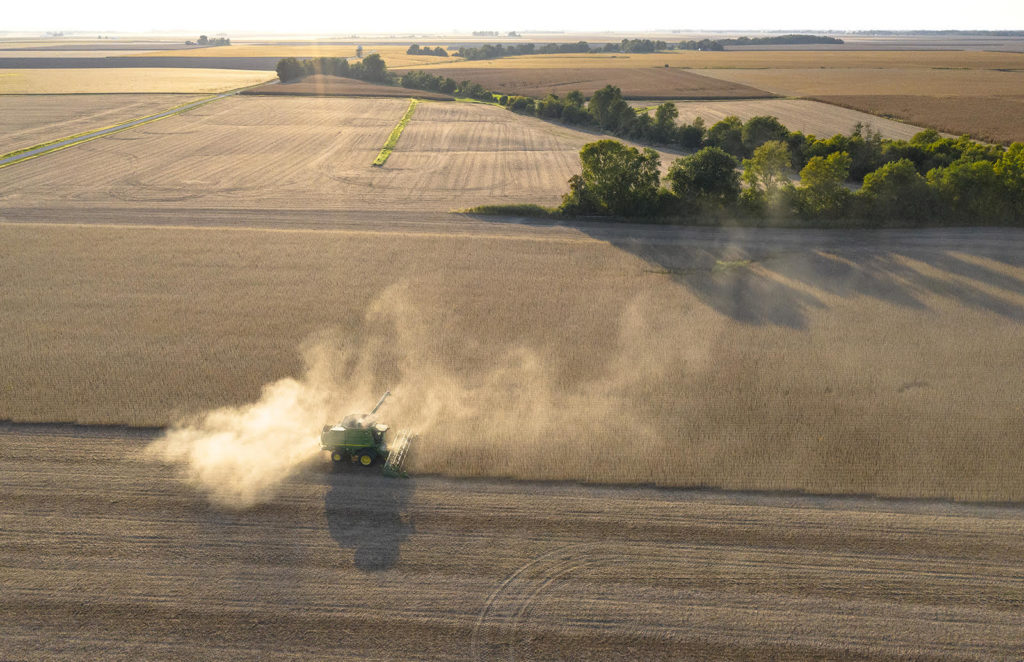After being laid off, Central Illinois photojournalist uses drones to elevate coverage of agriculture
Photojournalist Rich Saal stretched his neck toward the sky as he followed the drone he was flying over the immense Midwestern farming landscape in Central Illinois. Shades of brown and green stretch for miles with precise rows and columns tediously cut out by enormous machines. The scene captivated him, just as his grandfather’s farm did when he was growing up.
Most people would never realize how big farms actually are, Saal said. The drone “helps convey the enormous scale of the midwestern landscape and production farming.”
Saal photographs these breathtaking landscapes for a living. After more than 30 years of working in a newsroom, before he was unceremoniously laid off in 2019, he now captures one of the most essential industries in the Midwest: agriculture.
Saal worked at the State Journal-Register in Springfield before moving on to freelance commercial work. Now he is a Federal Aviation Agency-certified drone pilot, using the tool to tell the story of expansive Midwestern farms.
He has a long history with farming, growing up in Illinois– which is first in the nation with $180 billion in processed food sales. His roots in farming have made him especially interested in agriculture stories.
But as newspapers continue to cut jobs to stay afloat– roughly 33,000 newspaper jobs were lost from 2008 to 2018, according to the Pew Research Center— coverage on many industries, like agriculture, have also rapidly declined.
“Newspapers, definitely, are not covering agriculture,” Saal said.

(Photo by Rich Saal)
He recalls when journalists at the State Journal-Register were assigned to an agriculture beat because of how important farming was to their readers. Saal notes it still would be, but newspapers just don’t have the resources.
It is almost as though newspapers don’t even realize agriculture exists, Saal said.
The State Journal-Register, who is now apart of the Gannet-USA Today network, operates with a small staff of eleven in their newsroom– with only two photographers.
“Agriculture is important to central Illinois,” said Leisa Richardson, executive editor at the State Journal-Register. “While we don’t have the luxury of making it a standalone beat, we do include issues related to farming and agriculture in our business coverage.”
Though the news is falling short on farm coverage now, collegiate data shows that agricultural journalism may be on the rise. The nonprofit Midwest Center for Investigative Reporting in Champaign in central Illinois makes agriculture a key part of its coverage with recent stories on Covid-19 in poultry plants and potential regulatory rollbacks that impact farms.
According to Data USA, agricultural journalism and communications degrees have risen over 12% in recent years. They also show the University of Wisconsin– Madison, a historic Midwestern institution, as one of the top agricultural journalism degree granters in the country– though the degree is called “Life Sciences Communications” and encompasses all life sciences, not just agriculture.
More students are studying agriculture journalism, but it hasn’t translated to the workforce. Data USA doesn’t even list media or journalism as the top careers for this degree. They list agricultural managers, veterinarians, sales representatives and teachers as the most common career fields, while journalists or photographers failed to make it.
The salary for agricultural communication and journalism degree earners also doesn’t have a great outlook, falling nearly 3%, according to Data USA.
Drones, like the one Rich Saal uses, may be what agricultural journalism needs,
“There is much to be covered (in agriculture) and drones providing aerial views are a very crucial part of many of those stories,” said Mickey Osterreicher, general counsel at the National Press Photographers Association.
Drones have leveled the playing field, according to Osterreicher.
Instead of needing a plane or helicopter to capture the views from above, “journalists and news organizations can now safely get those same and sometimes better views without the expense of manned aircraft,” he said.
According to Osterreicher, journalists have had access to drones for years. In fact, the NPAA has held drone workshops for journalists since 2016, when the FAA started their drone certification test, Part 107.
“Since that time hundreds of journalists have obtained that certification and drone use for newsgathering by journalists is very prevalent throughout the country,” he said.
“The sky is the limit,” Osterreicher said.
Saal, who earned his FAA certification in November, is also excited about the potential of his new tool.
He described his goal as “getting up above the ground and looking down, putting that cornfield you see from that highway into perspective.”
Zachary Jarrell is an Ohio-based correspondent who is majoring in journalism at the University of Cincinnati (UC). Along with his work at Gateway Journalism Review, he is the Assistant Editor at The National Memo and an opinion writer at The News Record. Find him on Twitter @jarrell_zach